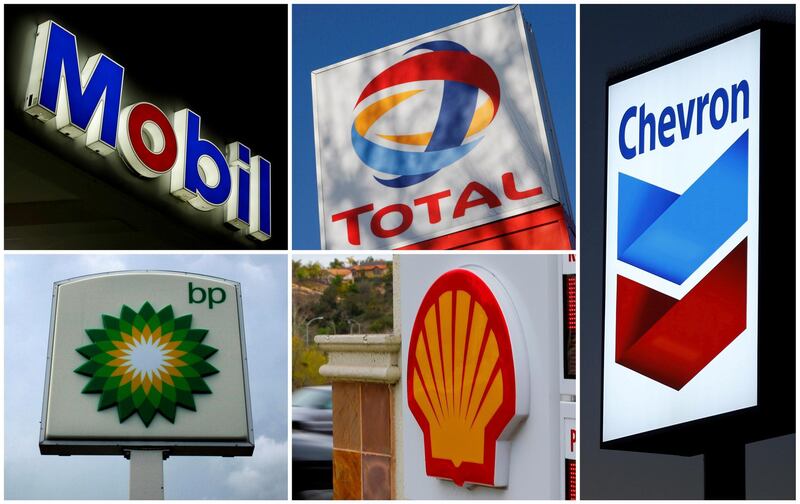Probably not since the Second World War have the big oil companies released earnings under such turbulent and unpromising circumstances. Their big losses and write-downs are shocking but unsurprising. Are they just the reflection of bad times, or indicative of flawed strategic choices, or do they point to a grim long-term future for the oil super-majors?
In the second quarter, lockdowns under the pandemic drove world oil demand to fall 16.4 million barrels per day, as estimated by the International Energy Agency, a drop far beyond any historical experience.
US oil prices famously went briefly negative. Brent crude, the international benchmark, tumbled to average $29 per barrel in the second quarter, from $67 per barrel at the end of last year, and that would have been far worse without the steep production cuts of the Opec+ alliance. The international oil firms’ production dropped too: some of it was located in Opec+ countries, some in the US and Canada simply became uneconomic.
Not surprisingly, oil companies’ second-quarter results are horrible. The American firms have been hit worst: Chevron lost $3.1 billion (Dh11.4bn), after non-cash charges; ConocoPhillips almost $1bn; ExxonMobil $1.1bn. ExxonMobil’s followed on its quarter-one loss, the first it had recorded in thirty years. Its operating cashflow was virtually zero.
Shell had already cut its dividend in April for the first time since World War Two. Yet it, Total and Equinor managed to beat analysts’ estimates and eke out small profits, while Eni lost $839m; BP reports on Tuesday.
Specialist trading companies, by contrast, did well. They benefit from volatility, from upsets in supply chains, and from storing commodities. Glencore expects full-year pre-tax profits to be around $3.2bn, compared to $1.32bn last year.
This partly explains why the European supermajors performed relatively better than their trans-Atlantic cousins. Shell, Total and Equinor all saw very strong profits in trading. ExxonMobil was buoyed by $1bn of refining profits, but neither it nor Chevron has a large trading operation. In fact, ExxonMobil’s early-stage trading operation managed to make a loss.
But the Americans are also hampered by their relative retrenchment internationally in favour of a recent focus on shale.
These relatively high-cost operations, with high decline rates, were hammered by the price slump, with some 2.2 million barrels per day of loss-making US production closed-in during the worst period, though now partly returning.
Chevron’s shale assets are widely acknowledged to be excellent, but plans to double output to about 1 million barrels per day by 2024, as much as Oman, have been replaced by an outlook in slight decline.
For this reason, BP’s results will be interesting: it has just completed the sale of its long-time Alaskan assets but remains the most exposed of the European supermajors to shale after buying BHP’s position back in October 2018.
So, in some ways, the integrated international oil company model has performed well. As intended, refining offset losses in upstream production at a time of falling prices, even though throughput dropped, while trading has been profitable in a turbulent period.
Diversification across a range of geographies and asset types helped the Europeans (as did a tax cut in Equinor’s home base of Norway). Their initial moves into “new energy”, including solar, wind and electricity retail, albeit tentative, have held up well and contrast with the US firms’ concentration on oil and gas.
But the short-term results, under the unusual situation of coronavirus, need to be separated from the longer-term outlook. Here, all the companies have announced massive write-downs and restructuring expenses: $5.6bn from Chevron, including the entire $2.6bn valuation of its Venezuelan assets; $8.1bn for Total; $16.8bn for Shell; a possible $17.5bn for BP.
The write-downs are mostly related to lower long-term views on oil and gas prices, which have dropped from $60-80 per barrel before the pandemic, to $50 per barrel, in Total’s view, and $60 per barrel by 2023, in Shell’s.
This resetting of long-term price expectations seems long overdue. It should not have taken a once-in-a-century pandemic to suggest that levels of $60-80 per barrel are very difficult to sustain when new shale drilling is profitable at the lower end of that range, and electric vehicles are fast-improving in cost and performance. The damage Covid-19 has wrought on demand really ought not to make much difference for prices in 2030 and beyond, which will be set by levels of investment, technological advances, and climate policy. Indeed, Total’s write-offs are mostly in its high-cost, high-carbon Canadian oil sands, which it sees as potentially “stranded” by climate policy.
In May, BP’s new chief executive Bernard Looney said the Covid-19 crisis may even have brought us to “peak oil demand” – and that worldwide consumption would never recover to pre-pandemic levels. That appears overly pessimistic. But the oil industry has been given a foretaste of peak demand, widely predicted to occur some time in the 2030s as electric vehicles and other non-oil technologies take over.
The strategies of the supermajors have diverged significantly in recent years, and the pandemic has been their first stern test. In a near future of great uncertainty and volatility for oil and gas firms, flexibility and diversification are the cardinal virtues. Coronavirus is a stiff but hopefully short-lived challenge; climate change is an existential one.
Robin M. Mills is CEO of Qamar Energy, and author of The Myth of the Oil Crisis







